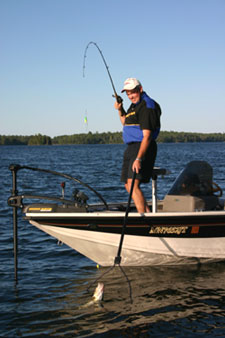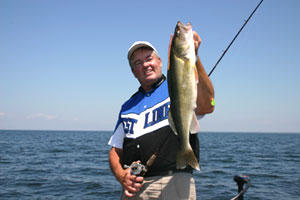 Riggers, jiggers, crankers, and bladers, all nicknames for anglers who use a particular method in pursuit of the elusive walleye.
Riggers, jiggers, crankers, and bladers, all nicknames for anglers who use a particular method in pursuit of the elusive walleye.
The most successful fisherman have become adept at applying all of the aforementioned techniques. While all methods can produce all year long; they’re not always the most productive method for that particular moment. Being able to read the conditions and adjusting your presentation can keep you on the fish.
Good “bladders” have learned that one of the most consistent producers across the country has been a spinner and live bait combination. Spinners are designed to add flash and vibration to live bait like crawlers, leeches, and minnows. Flash and vibration is delivered by a revolving blade at the front of the bait. Different blade shapes and sizes can vary the amount of vibration produced and they can also add a splash of color. Northland Tackle’s new Rock’n Rainbow Spinner comes with a new level of vibration and has an erratic and kind of crazy action that can drive walleyes nuts and is something they haven’t seen before. It’s available in some great colors and comes with a one or two hook harness.
The standard spinner comes tied with a pre-determined leader length, and can restrict its use. The Rock’n Rainbow has a short length of leader that holds the main body of the bait together and has no extended leader. Leader length is determined by the user which allows you the flexibility to adjust the length for each set of conditions.
One of the most common uses for a spinner employs the use of a bottom bouncer and a three or four foot snell. Popularized on the western reservoirs; bottom bouncers have allowed anglers to troll spinners through some pretty tough neighborhoods including rock, timber, and certain weeds. The wire tip of a bouncer keeps the bait elevated in the “zone” and out of the junk when used properly. The proper use includes keeping the bouncer as straight up and down as possible. If you get past a 45 degree angle on the line you have out to stay with the bottom the bouncer is going to lay down and lose all of it’s snag resistant properties. If you need the speed to trigger the fish you’re after it’s best to go up in bouncer size to keep it all under control and might mean using one as heavy as three or four ounces. The depth and speed you are trolling will determine the size bouncer that is required and the key is to go as light as you can while keeping the line as straight up and down as possible.
 Another method for trolling spinners while targeting open water fish incorporates an in-line keel sinker. When using in-line weights you can use up to a six or eight foot snell, to keep the weight as far from the bait as possible and out of the picture. To adjust the running depth anglers can either vary the size weight they’re using or vary the amount of line out.
Another method for trolling spinners while targeting open water fish incorporates an in-line keel sinker. When using in-line weights you can use up to a six or eight foot snell, to keep the weight as far from the bait as possible and out of the picture. To adjust the running depth anglers can either vary the size weight they’re using or vary the amount of line out.
Hanging on to a trolling rod all day can be tough on the body and a set of rod holders can make the chore much easier, but don’t get lazy. Good fishermen like to keep a rod in their hands for a couple of reasons; the first being the feel. If you’re hanging on you can tell if you’re getting hit and missed and know it right a way, which allows for quick bait replacement. It also allows you to set the hooks on the strike which can increase your strike to fish landed ratio. The second reason is the ability to add some extra
action. Instead of just pulling the bait along at trolling speed you’ll get more hits by pumping the rod forward and quickly dropping it back. The result is an erratic flash and flutter presentation that can help trigger the followers and the mildly interested.
Good spinner gear includes longer bait casting rods like St. Croix’s model TWC70MM Light Bouncer model with a medium sized reel loaded with eight or ten pound test Berkley Fireline. Fireline provides excellent feel and the super thin diameter will allow you to get away with using lighter bouncers. The combination of a high quality rod along with the braid will allow you to stay on top of your bouncers position and in complete control.
While spinners are one of the most consistent walleye producers year in and year out, they do have their time and place. For example; they really don’t come into their own until the water temps reach into the mid to upper fifties. However, when the time is right spinners can be the best thing going. When early season presentations start to fade like rigging and jigging, look for spinners to really pick up. They are also an effective method for covering lots of water. When looking for fish traditional rigging and jigging methods prove to be much too slow. Spinner speed can let you cover a lot more water by the end of the day and is the secret to actually finding fish. See you on the water.










